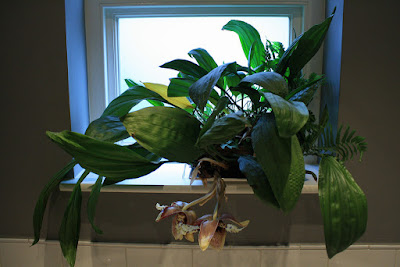Stanhopea tigrina is native to Mexico. This orchid grows on oaks in well-drained, dense forests on the eastern slopes of the Mexican Plateau at an altitude of 2000 m. Originally, it was found near Xalapa, Veracruz at an altitude of 1000-1300 m...
Stanhopea tigrina also called as The Tiger-Like Stanhopea, Epidendrum fragrantissimum, Maxillaria lyncea, Stanhopea expansa, Stanhopea nigroviolacea, Stanhopea tigrina var. atrata, Stanhopea tigrina var. aurea, Stanhopea tigrina var. aureo-purpurea, Stanhopea tigrina var.grandiflora, Stanhopea tigrina var. grandiflora, Stanhopea tigrina var. grandiflora, Stanhopea tigrina var. grandiflora superba, Stanhopea tigrina var. latimaculata, Stanhopea tigrina var. luteolo-violacea, Stanhopea tigrina var. lutescens, Stanhopea tigrina var.major, Stanhopea tigrina var. major superba, Stanhopea tigrina var. nigropurpurea, Stanhopea tigrina var. purpurea, Stanhopea tigrina var. speciose, Stanhopea tigrina var. splendens, Stanhopea tigrina var. superba, Stanhopea tigrina var. superba, Stanhopea tigrina var. superba, Stanhopea violacea, is a species of the genus Stanhopea. This species was described by James Bateman ex John Lindley in 1838.
IDENTIFY STANHOPEA TIGRINA
Stanhopea tigrina is native to Mexico. This orchid grows on oaks in well-drained, dense forests on the eastern slopes of the Mexican Plateau at an altitude of 2000 m. Originally, it was found near Xalapa, Veracruz at an altitude of 1000-1300 m, and later specimens of both varieties of typical Stanhopea tigrina and Stanhopea tigrina var. nigroviolacea were found in the mountains near Veracruz and Orizaba.
It is a cool to warm growing, medium sized, epiphytic species, which reaching 22-37 cm in height, with ovoid, slightly compressed, dark green, 4-6 cm long and 2.0-2.5 cm wide pseudobulbs carrying a single, apical, plicate, elliptic, petiolate, dark green, 20-35 cm long, 5-10 cm wide leaf.
The Tiger-Like Stanhopea blooms on a pendulous, 2 to 8 flowered, 15 cm long inflorescence that is subtended by large, chartaceous bracts, and carries large, fragrant flowers occurring in the summer and fall. The flowers are 8-17 cm in diameter. The petals and sepals are colored orange-yellow with wine-red spots, especially large at the base. The posterior lobe of the lip is golden yellow to orange with large red spots at the base and two large eyes on each side. The average proportion is brownish-white with a few purple specks. The anterior part is also brownish-white with small purple dots. On the lip there is a pair of sickle-shaped horns. In the variety nigroviolacea, the petals are almost entirely maroon.
STANHOPEA TIGRINA CARE AND CULTURE
Cultural information should only be used as a guide, and should be to be adapted to suit you. Your physical location; where you grow your plants, how much time you have to devote to their care, and many other factors, will need to be taken into account. Only then can you decide on the cultural methods that best suit you and your plants.
Light:
Stanhopea tigrina needs a light level of 25000-35000 lux. The light should be filtered and dispersed, and the plants should not be exposed directly to the sun in the afternoon hours. The majority of Stanhopea is reluctant to flower with insufficient light, but with too much light, the leaves tend to burn and yellowing. Strong air movement should be ensured all the time.
Temperature:
It is a plant with moderate thermal requirements. The average summer temperature is 25-26 ° C during the day and 14-15 ° C at night, which gives a daily difference of 9-11 ° C. In spring, the average temperature of the day in the spring is from 24 to 27 ° C, and the night from 11-15 ° C, with a daily amplitude increasing to 13 ° C. The average winter temperature is 21 ° C at day, 9-10 ° C at night, with a daily amplitude of 11-12 ° C.
Humidity:
The Tiger-Like Stanhopea needs the humidity of around 70-75% for most of the year, and at the end of winter and early spring it drops to around 50%.
Substrate, growing media and repotting:
Stanhopea tigrina are usually grown on rootstocks or in hanging baskets, because it is necessary in the case of hanging inflorescences that appear at the base of the pseudobulb and grow directly down. It seems that plants grow best and it is most convenient to grow them if they are attached to tree ferns. Fixed plants, however, require high humidity and at least daily watering in the summer, and it may even be necessary to water several times a day if the weather is dry and very hot.
These plants are also grown in wire baskets with large mesh moss-covered with sphagnum moss and filled with loose, quickly drying ground. The substrate should remain moist, but it can not be wet, because the roots must dry relatively quickly after watering.
Repotting or dividing should be done when the growth of new roots begins. This allows the plants to acclimatize in a relatively short time and provides them with the least stress.
Watering:
The plants should be irrigated abundantly during active growth, but their roots must dry quickly after watering, and the ground around them must never be spread or soggy. When new growths reach maturity in the autumn and flowering has finished, the amount of water should be drastically reduced.
Fertilizer:
During the active growth, the plant should be fertilized every week 1/4-1/2 of the recommended dose of fertilizer for orchids. You can use balanced fertilizer throughout the year, but you can also use fertilizer with increased nitrogen content from spring to mid summer, and then in the late summer and autumn, use a fertilizer with a higher content of phosphorus.
Rest period:
In winter, watering of Stanhopea tigrina should be limited, but must not be allowed to stay dry for a long time. Occasional fogging between uncommon watering should satisfy the requirements of these plants during the drought season. For about a month in winter, watering should be limited only to sporadic fogging, which will prevent excessive drying of the plant. Fertilization should be reduced or eliminated until new growths appear in the spring and more abundant watering starts.

















COMMENTS